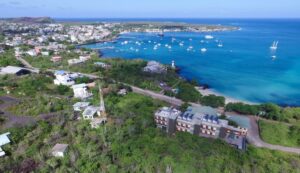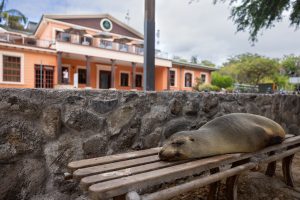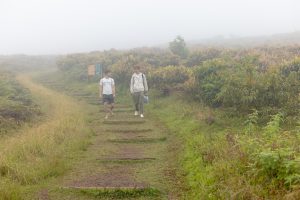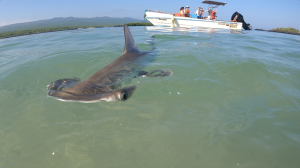Five Carolina research projects have received Galapagos Seed Grants for development at the Galapagos Science Center this summer.

From climate adaptation to biodiversity to the art of learning, this year’s recipients of the Galapagos Seed Grant Program span the spectrum of research topics. The funding enables and encourages new research initiatives in the Galápagos Islands of Ecuador, with a focus on the Galapagos Science Center (GSC) — a jointly developed and supported facility of UNC-Chapel Hill and the Universidad San Francisco de Quito (USFQ). The seed grants are made possible with support from the Ron Rindfuss & Steve Walsh Junior Faculty Galapagos Travel Grant fund and the UNC Office of Research Development.

GSC emphasizes the study of the social, terrestrial, and marine sub-systems of the islands with a focus on population, health, and environment. Seed grants are geared toward junior faculty and new project initiatives, or to enhance existing projects that lead to external grant applications. Previous recipients have gone on to receive additional funding to expand their research. In 2021, Alan Jones and Corbin Jones’ study on genetic characteristics of grasses across Ecuador received $1.2 million in funding from the National Science Foundation.
Seed grants offer up to $5,000 in funding to individual researchers and up to $7,500 for collaborations. By providing a launch board to test hypotheses and gather initial data, Carolina and GSC can attract the best and brightest researchers, whose studies will impact on the islands and beyond.
The 2022-2023 recipients of Galapagos Seed Grants are as follows:
Paul Taillie, assistant professor of geography, Institute for the Study of the Americas
Native Galápagos wildlife responses to invasive species management and sea-level rise
The Galápagos Islands represent one of the most well-known examples of the critical role that islands play in contributing to global biodiversity. In recent decades, ambitious invasive species removal programs have successfully eradicated cats, goats, pigs, and even rats from several islands in the archipelago. This study aims to investigate responses to these efforts among one of the least well-understood vertebrate taxa endemic to the Galápagos, the Nesoryzomys rodents.
A better understanding of how these rodents have responded to conservation efforts is imperative, given they are likely to face emerging threats, such as rising sea level. Ultimately, the work will inform biodiversity conservation on the Galápagos and other islands, while also helping to address the global biodiversity crisis.
“As a wildlife ecologist, the Galápagos is one of those locations many of us only dream about researching,” Taillie says. “I’m incredibly excited by this opportunity and hope to turn it into something long-term.”
Senay Yitbarek, assistant professor of biology, College of Arts and Sciences
The interplay between global change and host-pathogen dynamics
This research examines the interaction between global change and host-pathogen dynamics with a focus on island plant-pollinator-network dynamics. Extensive surveys will be performed to assess plants and pollinator species that differ in geography, phylogeny, and non-native species across the Galápagos Islands. Samples will be collected from pollen and nectar resources of flowers and from the mouthparts of captured pollinators to broadly characterize the virome in wild and agricultural plant species. Lastly, an empirical plant-pollinator-virus matrix that spans the islands will be constructed.
 Troy D. Sadler, Thomas James Distinguished Professor of Experiential Learning, School of Education
Troy D. Sadler, Thomas James Distinguished Professor of Experiential Learning, School of Education
The power of place for education: An exploration of place-based learning in the Galápagos
The intersection of the Galápagos as a place that inspires scientific discovery and the educational opportunities that have emerged in this place is the focus of inquiry for this project. As a part of this work, researchers will explore learning as it happens in undergraduate study abroad experiences in the Galápagos. This is the first step in a broader agenda to systematically study place-based learning as it happens in the islands, develop a Galápagos-informed model of place-based learning, and explore how this model can impact other learning environments.
This model will inform strategies to connect learners in North Carolina and beyond with the science and unique physical attributes of the Galápagos Islands. Multiple forms of data, including interviews, observations, and surveys, will be collected with the goal of understanding what study abroad participants learn, how the Galápagos Islands shape learning processes, and how insights about learning in this region inform a more general model of place-based education.
“The GSC offers a unique opportunity for science and education, and we are excited to initiate a research program that connects with this resource,” Sadler says.
Caela O’Connell, assistant professor of anthropology, College of Arts and Sciences
Agri(cultures) of disease and climate adaptation in the Galápagos
This project will collect human and environmental data to identify food, water, and agricultural challenges with research needs in the Galápagos to better understand if climate adaptive strategies needed for the islands are also potential solutions for coping with food and water insecurity and/or invasive species, even at the microbial level.
This preliminary work is guided by two research aims: to assess the feasibility of the Galápagos and coastal adjacent regions as a site for complex communities of culture and disease impacting banana farmers or a proxy agricultural crop, and to assess issues of climate adaptation, food and water insecurity, and inequality in Galápagos in parallel with ongoing studies on Ocracoke Island, N.C. In both respects, the study will be pursued in collaboration with other researchers and students from UNC-Chapel Hill, USFQ, and community members and stakeholders.
 John Bruno, professor of biology, College of Arts and Sciences
John Bruno, professor of biology, College of Arts and Sciences
Savannah Ryburn, PhD student and graduate research assistant in biology
Movement patterns and habitat use of juvenile scalloped hammerhead sharks
The scalloped hammerhead shark is a critically endangered species that is iconic to the Galápagos archipelago. Numerous species of sharks use nursery habitats as juveniles and, recently, the first scalloped hammerhead nursery was discovered near San Cristóbal Island. Little is known about this species at the juvenile stage, including how long they reside in the nursery habitats, movement among nurseries, diet, and why certain bays are chosen as nurseries. The goal of this project is to elucidate the movement and ecology of this species as juveniles in the Galápagos by utilizing acoustic telemetry, PIT tags, BRUVS, and metabarcoding shark fecal matter.
“The Galapagos Seed Grant is providing us with the funds to purchase acoustic tags that we will use to track the juvenile sharks for 24 hours,” Ryburn says. “This valuable information will allow us to see what habitats these sharks are using as juveniles and enable us to better conserve this critically endangered species at all life stages.”